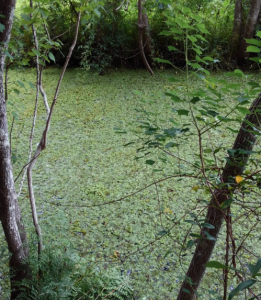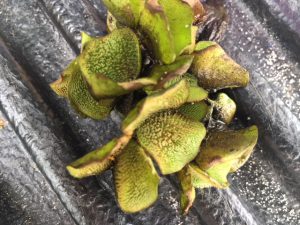Giant Salvinia (Salvinia molesta) is an aggressively spreading free floating plant that can cover the surface of a water body reducing water flow, sunlight penetration, and dissolved oxygen to a point where the over health and biodiversity of the water body is compromised – we do not want it here.

Photo: Escambia County Division of Natural Resources
The plant is originally from Brazil and was probably brought here for oriental ponds and aquariums. The plant is so aggressive and detrimental to waters it invades that in 2013 the International Union for the Conservation of Nature listed it as one of the world’s 100 worst invasive plants. Locally it is listed as a federal noxious weed and is prohibited in the state of Florida.
It has been found in Pensacola. We, along with Bay County, are the only two counties in the panhandle with the plant. Something that is not so good. We would like to get rid of what we have and control the spread to other waterways and counties.
How do we do this?
Well, FWC has a team based out of Panama City that focuses on control and removals – they are on it. We know locally it has been found in the Jackson Lakes near Bayou Chico, and – even though it is a freshwater plant – has been found in the upper reaches of Bayou Chico itself. FWC is currently treating known locations but we need the help of shoreline residents controlling the plants that are in front of your property.

Photo: Rick O’Connor
It is a floating plant, resembling duckweed but the leaves are larger (1-4” in length). The hairy looking roots hang in the water to gather nutrients. There bundles of small hair like structures on the surface of the curved leaves. Groups of four hairs rise vertically and touch at the tips (resembling an egg beater or wisp). They are very small, but with a magnifying glass you can see these. If found, you can use a hand-held crab net to dip them out of the water and place somewhere they can dry out and die. They spread quickly by fragmentation and spores. So be sure to collect all fragments of the plant.
If you do find, please let us know here at the extension office so that we can report this to FWC.
You can also report the plant on https://www.eddmaps.org/.
You can learn more about this invasive plant at http://plants.ifas.ufl.edu/plant-directory/salvinia-molesta/.
 0
0
